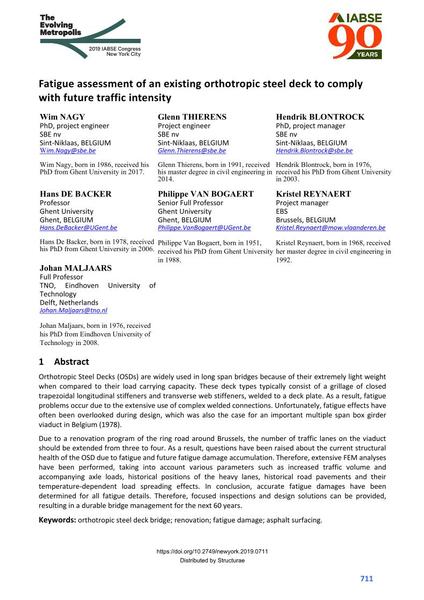Fatigue assessment of an existing orthotropic steel deck to comply with future traffic intensity

|
|
|||||||||||
Bibliographic Details
| Author(s): |
Wim Nagy
(SBE nv)
Glenn Thierens (SBE nv) Hendrik Blontrock (SBE nv) Hans De Backer Philippe Van Bogaert (Ghent University) Kristel Reynaert (EBS) Johan Maljaars (TNO, Eindhoven University of Technology) |
||||
|---|---|---|---|---|---|
| Medium: | conference paper | ||||
| Language(s): | English | ||||
| Conference: | IABSE Congress: The Evolving Metropolis, New York, NY, USA, 4-6 September 2019 | ||||
| Published in: | The Evolving Metropolis | ||||
|
|||||
| Page(s): | 711-717 | ||||
| Total no. of pages: | 7 | ||||
| DOI: | 10.2749/newyork.2019.0711 | ||||
| Abstract: |
Orthotropic Steel Decks (OSDs) are widely used in long span bridges because of their extremely light weight when compared to their load carrying capacity. These deck types typically consist of a grillage of closed trapezoidal longitudinal stiffeners and transverse web stiffeners, welded to a deck plate. As a result, fatigue problems occur due to the extensive use of complex welded connections. Unfortunately, fatigue effects have often been overlooked during design, which was also the case for an important multiple span box girder viaduct in Belgium (1978). Due to a renovation program of the ring road around Brussels, the number of traffic lanes on the viaduct should be extended from three to four. As a result, questions have been raised about the current structural health of the OSD due to fatigue and future fatigue damage accumulation. Therefore, extensive FEM analyses have been performed, taking into account various parameters such as increased traffic volume and accompanying axle loads, historical positions of the heavy lanes, historical road pavements and their temperature-dependent load spreading effects. In conclusion, accurate fatigue damages have been determined for all fatigue details. Therefore, focused inspections and design solutions can be provided, resulting in a durable bridge management for the next 60 years. |
||||
| Keywords: |
fatigue damage renovation orthotropic steel deck bridge asphalt surfacing
|
||||
